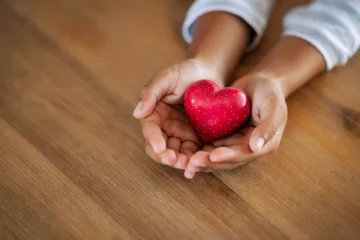How we can heal together:
Somatic Couples Therapy Explained - An Interview

Our most intimate relationships challenge us like no others do, showing us the unhealed wounds that we carry deep inside so we can finally face and heal them. We grow and heal in connection with others, but sometimes, it seems like this connection is irrevocably lost, and there’s no way to restore it. When our partner suddenly feels more like a stranger or an enemy rather than the person we can open up to, when it’s hard to find a common language or mutual understanding, a relationship may need help – not just through words.
In this interview, I speak with my colleague Arpitha Shankar about somatic couples therapy. Arpitha is a body-oriented, attachment-informed trauma practitioner and a couples therapist at Back To Your Body. She is trained in Somatic Experiencing, Bodynamics, and is currently completing her training in the Neuro-Affective Relational Model.
In this conversation, we are diving into what somatic couples therapy is, how it works, and why bringing the body into relationship healing can be such a transformative experience. If you’re in a relationship and looking for support or are curious about somatic therapy, I hope you find some valuable insights in what Arpitha has to share.
Watch the conversation or read the transcript below.
What Is Somatic Couples Therapy and How Is It Different From Traditional Talk Therapies?
Arpitha:
In somatic couples therapy, I work on integrating the body into the healing process. Traditional talk therapy primarily focuses on verbal communication, cognitive understanding, and strategies to dialogue better. All of these strategies are very valuable; however, they need to be built on the foundation of bodily awareness.
In the somatic work, we recognise that these relationship patterns are stored not just in our thoughts, but in our bodies as physical sensations, tensions, and movements. Many times, we learn strategies to be more responsive and less reactive, but then we short-circuit the key wisdom – what comes in the way when trying to implement these strategies? This is uncovered in somatic work. It provides very valuable information through physical sensations that often precede conscious awareness and cognitive processing.
Co-regulation and the Body’s Role in Communication
The beauty of somatic couples work is that you realise that you have another person to co-regulate with. For example, managing a conflict can be compared to driving a car on the highway and having the awareness of how early to press the brakes so that you’re not crashing into the car ahead of you. These are all strategies of dialoguing that one develops. But even before that, there is so much happening in our body that recognises what is the safe distance to brake the car? How do I manoeuvre the speed so that we are still safe? All of this decision-making can be compared to inner regulation awareness, which is done by the body.
Sometimes, in a somatic couples therapy session, even if you are agitated inside, but your partner is grounded and present because the therapist is holding the container, it opens the ground to co-regulate and approach conflicts as a team rather than “you versus me.” So, the body serves as a very important resource for grounding and authentic presence during difficult conversations. These are some of the ways somatic couples therapy differs from traditional talk therapy.
What Happens in a Typical Somatic Couples Therapy Session?
Elena:
What a typical somatic couples therapy session looks like? Are there specific techniques or practices you often use?
Arpitha:
A typical session might include, and would start with, checking in verbally and with somatic awareness. It could be very presence-oriented guiding questions to help couples come into the here and now: “What are you noticing in your body right now? What parts of your body are alive?”
A typical session starts with slowing down so that we can have more presence for the interactions that are going to unfold. When we slow down and stay with the interactions with presence, we can also track the physical responses that accompany communication.
When guided through this process, I’ve seen a partner say, “I’m willing to receive what you’re sharing as long as you’re not wagging your fingers.” As you see, the wagging of the fingers was so enmeshed with the information that this partner was so intensely trying to communicate. However, for the other partner, because of whatever life experience they’ve had, finger-wagging felt very unsafe. But the information itself wasn’t unsafe. So it helps to discern and differentiate elements of the communication and not become hijacked by the unsafety.
Working with Boundaries, Space and Safety in Relationships
A typical session would also include boundary exercises to experience healthy connection and separation. Separation is also healthy, but many times, we come into intimate relationships with very traumatic experiences of separation. So, negotiating space can be a big point of connection by somatically feeling connection and separation through boundary work, and certain exercises that enable co-regulation.
I also enjoy facilitating movement exercises to explore patterns of pursuing and withdrawing. What does it mean for you to be pursued? What does it mean to pursue someone? What does withdrawal mean? And how do you communicate your impulses to withdraw? So, it’s about exploring all these nuanced ways of emotional dance between couples.
Another key piece is developing a felt sense of safety and trust in relationships. There’s often a conscious or unconscious expectation that my partner should give me safety. While yes, as individuals we hold responsibility and commitment to safety, the foundation of that is your own inner relationship with safety – how safe you feel within. From that place, you can communicate what safety means to you, and your partner can take responsibility for the ways they may make you feel unsafe. Because it’s very possible and natural, even when in love, for someone to make you feel unsafe simply because they don’t know what it means for you. When you communicate that, they can take responsibility without spiralling into shame.
What If One Partner Feels Hesitant About Somatic Work?
Elena:
Some people may feel hesitant or even resistant toward body-focused work, especially if they’re new to it. How do you support couples, or one partner, who feels uncomfortable with this part of the process.
Arpitha:
It generally helps if both partners have done individual work with a somatic trauma practitioner and explored their childhood trauma or patterns of wounding. But sometimes it’s not the case, and they’re uncomfortable with somatic work. I see that as wisdom – the body resisting deep somatic work.
My job as a therapist is to honour that wisdom and not rush in or give breathing exercises that make them feel they have to work hard, or feel guilty for not feeling their body enough. I take a lot of care to make sure I don’t even inadvertently make them feel that way.
Starting Small and Respecting Readiness
I start with very gentle awareness practices rather than intense physical interventions. For example: “Can you place your hand on your palm? Can you feel the palm on top? Can you feel the palm underneath?” These are simple awareness practices that are gentle for them, not something that I judge as gentle.
Some people are more cognitive and relate better to logic and rationality. For them, a bit of psychoeducation and explaining the neuroscience behind body-based approaches can help soften the resistance. A key piece is respecting their boundaries and offering a choice about the level of participation they want. I’ve seen that alone soften resistance in the body.
At times, I might reflect on what I see: “When you said you didn’t want to talk, I noticed your chest was upright and your jaw was tight.” That mirroring becomes a bridge to somatic awareness. I also use metaphors and visualisations if direct physical sensation is too much. Instead of asking, “What do you feel in your chest?”, which can feel confronting, I might invite something more symbolic. Some people are very visual and imaginative, and that becomes a bridge.
And finally, I normalise the discomfort. It’s not meant to feel comfortable or exciting all the time. Just like learning any new skill, there’s a teething stage. It can feel awkward, and that’s part of the process.
What Relationship Issues Can Somatic Couples Therapy Help With?
Elena:
Would you say somatic couples therapy is suitable for all kinds of relationships or relational issues? Can you give some examples?
Arpitha:
Yes, this model can be adapted to very diverse relationship structures. The most common issue couples come to me with is a communication breakdown and feeling emotionally hijacked by patterns of reactivity in conflicts. It could show up as withdrawing, shutting down, stonewalling, or sarcasm, all of which can really get in the way of authentic connection.
So the first step is to become curious – what role does sarcasm play? What role does withdrawal play? How does it keep you functional in this relationship? And it’s important not to look at it as a dysfunction, but as a bid for connection. When we bring in this awareness, it leads to compassion, because now we can detach from their reactive patterns and see them as adaptive strategies they’ve learnt to survive.
Rebuilding Trust, Navigating Differences and Emotional Disconnect
I also work with rebuilding trust after betrayal, where safety needs to be felt in the body – helping partners come back to what safety feels like, and then rebuilding trust from that place.
Other issues include parental disagreements that can trigger strong emotional responses due to the developmental trauma involved, as well as cultural differences in expressing and perceiving emotions. These days, I see a lot of couples from different cultures and ethnicities who bring their own cultural perspectives and upbringings, which shape the way they idealise relationships.
And also, I work with couples who have become like roommates, raising children, and feeling that they don’t exist as lovers anymore, but just individuals on autopilot, fulfilling responsibilities. In all these situations, somatic couples therapy can be greatly beneficial.
How Trauma Shows Up in Relationships
Elena:
What are some signs of unresolved trauma that might show up in a couple’s dynamic?
Arpitha:
Some of the indicators might include disproportionate reactions to minor triggers. When I say “minor triggers,” it’s in no way to invalidate the importance of whatever is triggering. It’s to recognise that our reactions are always proportionate to the original context in which they came into existence in our lives.
In couple interactions, a partner may feel like: “Why is he or she overreacting to something as simple as throwing a wet towel on the bed?” So if you notice a lot of such disproportionate reactions to seemingly small triggers, it could point to unresolved trauma that’s affecting the relationship.
Somatic Signs of Unresolved Trauma
It can also show up as a physical shutdown or flooding during conflicts, when conflict feels so overwhelming that you lose your presence or centre. Another sign could be difficulty with boundaries: the inability to say no, to ask, or to state your needs. Or even the belief that “I need to be understood without having to say anything.”
All of these can be signs of emotional or somatic baggage that needs processing. It could also include rigid physical responses during disagreements, like freezing or aggression.
Another key sign is the inability to stay present during intimate moments. That’s something that can also be addressed in couples work.
So, in essence, we’re working with physiological patterns that talk therapy alone may not be able to reach. And through this work, couples can begin to create a sense of safety both within themselves and between one another, at the level of the nervous system.
How Long Does It Take to See Results in Somatic Couples Therapy?
Elena:
How long does it typically take for couples to notice changes or improvements? What kinds of changes do couples commonly experience through this work?
Arpitha:
Most couples start noticing subtle changes in about 6 to 8 sessions. Though for very deep pattern changes, it usually takes a minimum of 3 to 6 months of consistent work.
Signs of Progress and Shifts Toward Intimacy
But what are the indicators that tell us that we’re on the path of improvement?
It starts with greater awareness of early warning signs before conflicts escalate. I often tell couples that it’s not just because you come to couples work, you stop fighting or having conflicts. That’s not the idea. The idea is that you learn to fight so well that conflicts become portals to deeper intimacy.
So once you have greater awareness of the early warning signs, you also develop more capacity to exercise restraint. Even if a big part of you wants to say something, you are able to pause and feel into the energetic intention, asking yourself: “Is my intention to connect? Or is there some vindictiveness or old pattern fuelling this moment?”
Another sign is the ability to stay present during difficult conversations by feeling your body and your feet, and using the exercises we’ve practised in sessions.
And couples therapy is not only about focusing on what’s not working. It’s also about focusing on what is working. How do you grow the coherence between you both?
As a result of this work, you may notice a deeper sense of connection and attunement as you learn each other’s love languages. There’s also more satisfying emotional and physical intimacy. You may notice you now have more embodied resources to manage stress together, to communicate your inner landscape better with more personal leadership and accountability, rather than speaking from a place of helplessness. So you might feel that now there is more inner leadership.
Common Misconceptions About Somatic Couples Therapy
Elena:
Are there any common misconceptions that you sometimes come across about somatic couples therapy?
Arpitha:
Yes, one common misconception I heard from a prospective client was that it’s about giving each other some form of somatic massage and getting guidance on that. Sometimes there’s this preconception that it’s all about touch and massage.
But no, it’s much more about how we build bodily awareness while also working with cognitive reframing of the ways we relate to each other. It’s about building both those bridges simultaneously. It’s not only about touch, and it’s definitely not massage.
For Couples Who Are Curious, But Hesitant To Start Somatic Couples Therapy
Elena:
For couples who are curious but unsure, what would you say to them? What’s a good first step or mindset to bring?
Arpitha:
Many times, we think love alone is enough. But the hard truth is that intimate relationships mirror the deepest woundings in us. And it takes a lot of courage to face those wounds. It is deep work. However, on the other side of that deep work is more fulfilment, more connection, and greater relational satisfaction.
Reconnecting with Choice and Possibility
Many couples feel like it’s the end of the road and that they just have to put up with it. There’s a sense of helplessness or choicelessness that many people, unfortunately, sign up for. But it doesn’t have to be that way.
The very feeling of being choiceless is a sign of trauma, because trauma makes you feel like there’s no other option but this. However, with intention, support, and courage, there is hope. There is a possibility, even if you don’t see it yet.
I have faith that, just like a creeper moves toward sunlight and resources, we have an inner impulse to move towards connection. We are wired for it. So I hope you can trust that inner impulse that’s nudging you towards connection, lean into it, and allow yourself to see the possibilities that might unfold.
Elena:
Thank you so much, Arpitha, for this conversation and for sharing your expertise and perspective.
If you’re interested in learning more or exploring this work with Arpitha, please follow the links below.
And stay connected to yourselves, your bodies, and each other.
You can also listen to this conversation on Podbean or Spotify.
If you have any questions, visit our FAQ page or get in touch with us.

I’m Elena Jacinta, a Somatic Experiencing practitioner and the founder of Back To Your Body, an online somatic therapy practice offering a supportive space to attend to your nervous system and trauma through the body. At Back To Your Body, we help individuals and couples with nervous system regulation, psychosomatic symptoms, shock trauma, developmental/ attachment trauma, systemic and generational trauma.



